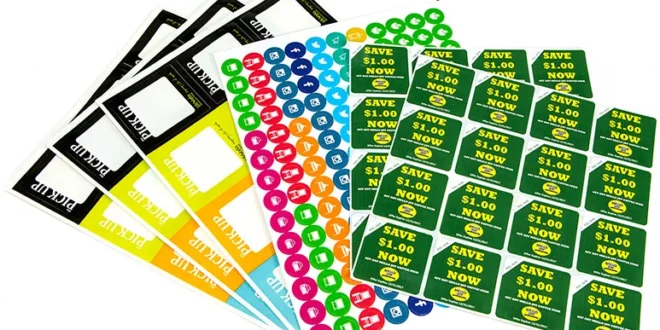Among the most often used label types in a broad range of applications are sheet labels. However, what are they, and how are they employed? What distinguishes them from roll labels? If you are someone who needs sheet labels and is perplexed about using them, here are some essential details you must go through to make an informed decision. Read ahead to know more!
What are Sheet Labels?
Labels printed on sheets are commonly used in companies and residences. You can easily store these labels because they have robust liners that keep them flat. The most common size is 8.5 x 11 inches, but there are also larger options like 8.5 x 14 inches, 11 x 17 inches, and 12 x 18 inches. Labels can be die-cut, have rounded edges, be oval, rectangular, square, or circular, and have varying sheet sizes. Numerous vendors even provide a range of colors to suit your requirements.
In addition, sheet labels are frequently offered for sale in packs or boxes of a particular number. Sheet label packs normally contain 5, 10, and 25 sheets, whereas boxes are meant to carry greater amounts of up to
How are Labels for Sheets Made?
Continuous pressure-sensitive laminates make sheets labels, then sliced into separate sheets. An outline of how they are created is provided below:
They begin as sizable rolls of release liner-containing coated or uncoated sticky film or paper. The rolls are divided into designated widths and sheet sizes, typically 8.5 x 11 inches. The sheets are die-cut into the required label shapes and sizes using a rotary blade or laser heat.
Moreover, Biaxially Oriented Polypropylene (BOPP) creates sheet labels. Additionally, they come in various finishes that allow them to withstand grease, water, and UV rays. Even gloss and matte white versions are available.
Where are Sheet Labels Useful?
1. Product Labelling
When labeling products, sheet labels printed by industrial label printers are mostly utilized. Details about the goods, including the name, price, and barcode, can be printed on them. Usually, vinyl or paper are used to make product labels.
2. Address Labels
Address labels can be made with sheet labels. Paper or polyester are the usual materials used to make address labels. The recipient’s name, address, and phone number may be printed on them.
3. Shipping Labels
Shipping labels can be made with sheet labels. Usually, shipping labels are composed of polyester or paper. The sender’s name, phone number, and address can be printed on them.
4. Name Badges
Name badges can be made with sheet labels. Most name badges are composed of polyester or vinyl. The name and title of the individual might be printed on them.
5. Warning Labels
Warning labels can be made with sheet labels. Most warning labels are composed of polyester or vinyl. They could be printed with a cautionary phrase like “Danger” or “Caution.”
6. Decals
You may make decals out of sheet labels. Most decals are composed of polyester or vinyl. They can have a pattern, emblem, or text printed on them.
7. Magnets
Magnets can be made using sheet labels. Most magnets are constructed from polyester or vinyl. They can have a pattern, emblem, or text printed on them.
Stickers can be made with sheet labels. Vinyl and polyester are commonly used to make stickers. They can have a pattern, emblem, or text printed on them.
Difference Between Sheet Labels and Roll Labels
Sheet labels come in sheets, as was previously noted. Conversely, roll labels are available in rolled formats. As sheet labels have already been covered, to clarify the distinction between the two further, we will also define roll labels and their suggested applications.
Roll labels are labeled in continuous strips wound around cores and have liners. Roll labels lack a supporting substance, whereas sheet labels do. However, they are often constructed using the same materials and adhesives as sheet labels. The primary distinction is that roll labels are wound around plastic or cardboard spools instead of flat sheets.
Additionally, you can only use industrial label printers—such as inkjet roll printers, thermal transfer printers, and direct thermal printers—that are made especially for roll labels. When it’s time to print, they are mounted within your printer and emerge individually. Roll labels are, therefore, perfect for automation applications or bulk printing. Finally, there are three standard sizes for roll labels: 1″ core, 2″ core, and 3″ core.
How to Choose the Right Sheet Label?
1. Label Size
The label’s size is the second thing to consider. There are numerous sizes for sheet labels. Select a size that fits the needs of the application.
2. Label Material
The label’s material should be considered as the third factor. Sheet labels come in various materials, such as polyester, vinyl, and paper. The most popular kind of label is one made of paper. Vinyl labels are stronger and more resilient to chemicals and moisture. The most resilient label material is polyester, resistant to high temperatures.
3. Label Adhesive
The label’s stickiness is the fourth thing to consider. There are numerous adhesive formulae, such as removable, repositionable, and permanent. The purpose of permanent adhesives is to adhere to surfaces indefinitely. Labels may be taken off and put back on thanks to repositionable adhesives. Labels can be removed with removable adhesives without causing any damage to the surface.
4. Printing
Printing is the fifth thing to take into account. Many techniques, such as offset, screen, and digital printing, are available for printing sheet labels. The most often used technique for creating sheet labels is digital printing. For printing huge amounts of labels, screen printing works well. The greatest technique for high-quality printing is offset printing.
Find The Best Sheet Labels at DAL
For efficient labeling requirements, it is essential to comprehend the subtleties of sheet labels. Accurate and long-lasting labeling is ensured by considering factors including materials, adhesives, and printing techniques. Armed with this knowledge, you may choose DAL’s sheet labels with confidence for various applications, maximizing communication and organization.
Did you learn something new from this article? If so, be sure to check out our blog for more educational content.
 SlushWeb Live the Way You Love
SlushWeb Live the Way You Love


